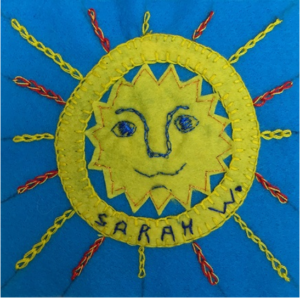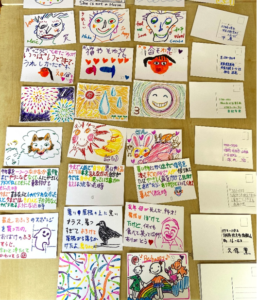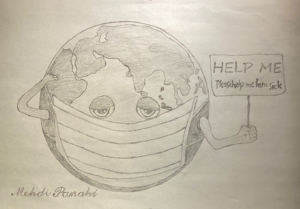Arts & homelessness: how creativity & activism are addressing isolation

Across history, artists have always been on the front line of activism – activism around issues of conflict, climate change, poverty and injustice. There is a passion that drives many artists of all genres to stand up to be counted and not accept the status quo. They mobilise and find ways to express an issue in a different, artistic way which often produces more impact than discourse alone. Who could forget the plastic bottle boat outside the UK parliament, the pink seesaw installation between the border of USA and Mexico or the work of artist and HIV campaigner Keith Haring in the 1980s. A diamond, they say, is made ‘under pressure’ and many diamonds have been formed in society by artists when we have faced our darkest moments.
“A diamond, they say, is made ‘under pressure’ and many diamonds have been formed in society by artists when we have faced our darkest moments.”
The COVID-19 pandemic has been no different in that artists (despite many losing work and jobs) have joined the front-line once more. In homelessness, the positives of 5,500 people sleeping rough being housed in empty hotels in the UK has been countered by significant isolation since many people in this group were shielding because of underlying health issues. And the majority of this group is isolated further by not having Smart phones and laptops so are digitally excluded and unable to access the wealth of on-line content that suddenly exploded onto the airwaves.
Rising to the challenge
 This dual challenge of fighting isolation and creating projects offline became the focus of a number of arts activists in homelessness. Arthur and Martha in the North West started an embroidery project through Booth Centre in Manchester and others (see photo of embroidered sun by Janet Downs); Underground Lights, Crisis Coventry, Arty Folks, Belgrade Theatre and Coventry City of Culture 2021 joined forces to create art packs and art projects e.g. mask-making and a ‘Send a Smile’ postcard project (which WOV is helping to expand to people in temporary accommodation including Housing First and some national and international partners e.g. Cocoroom in Japan – see photo); to date, Accumulate have delivered over 3,500 art packs to hotels and hostels around London and Bristol.
This dual challenge of fighting isolation and creating projects offline became the focus of a number of arts activists in homelessness. Arthur and Martha in the North West started an embroidery project through Booth Centre in Manchester and others (see photo of embroidered sun by Janet Downs); Underground Lights, Crisis Coventry, Arty Folks, Belgrade Theatre and Coventry City of Culture 2021 joined forces to create art packs and art projects e.g. mask-making and a ‘Send a Smile’ postcard project (which WOV is helping to expand to people in temporary accommodation including Housing First and some national and international partners e.g. Cocoroom in Japan – see photo); to date, Accumulate have delivered over 3,500 art packs to hotels and hostels around London and Bristol.
“The dual challenge of fighting isolation and creating projects offline became the focus of a number of arts activists in homelessness.”
 This offline work sits alongside a number of online projects where the likes of Streetwise Opera, Choir with No Name, Cardboard Citizens and others are now running regular sessions over the internet and new projects such as Lockdown Lives in Manchester have been created. In Seattle, USA, Path With Art used financial reserves to buy all members tablets so they could remain connected to PWA and each other. Some, like Museum of Homelessness in London and Pehchan in Mumbai have taken activism a stage further, the former setting up a Homelessness Taskforce in their area and the latter delivering food and water as well as art materials to 21,000 homeless people in the city.
This offline work sits alongside a number of online projects where the likes of Streetwise Opera, Choir with No Name, Cardboard Citizens and others are now running regular sessions over the internet and new projects such as Lockdown Lives in Manchester have been created. In Seattle, USA, Path With Art used financial reserves to buy all members tablets so they could remain connected to PWA and each other. Some, like Museum of Homelessness in London and Pehchan in Mumbai have taken activism a stage further, the former setting up a Homelessness Taskforce in their area and the latter delivering food and water as well as art materials to 21,000 homeless people in the city.
“In Seattle, USA, Path With Art used financial reserves to buy all members tablets so they could remain connected to PWA and each other.”
New connections
What is striking and positive is that these projects are not only reaching existing members but a whole new group of people who had not engaged with these projects before – in particular, in the UK, people who had moved from the streets to hotels. Homelessness key workers are working more intensively with them than on the street, supporting their needs and arts interventions are following suit.
Geetha Rabindrakumar from Cardboard Citizens was volunteering in a St Mungo’s-run hotel in London early on in the pandemic: ‘After volunteering and providing donated books to residents, I saw a need and opportunity to provide creative engagement to guests in strict isolation. We have been running a collaborative trial in this hotel, with us, Accumulate providing art packs, and the Reader is running 1:1 Shared Reading sessions over the phone with a number of guests. We at Cardboard Citizens have been running a weekly facilitated creative challenge for a group of guests – each week the guests produce a piece of work in response to a creative challenge or question, and then discuss their work together over Zoom with an artistic practitioner.’
Key themes
Geetha says that there are some key themes emerging:
‘The critical role of support from the local staff and volunteers in the absence of being able to build face-to-face relationships and trust to outline our work and why it could be helpful for guests.
– The benefits that local staff have seen by offering a lifeline to clients in strict isolation and supporting their mental wellbeing.
– The benefits that the guests have expressed to us (and are visible in Cardboard sessions) around the pleasure they have gained from being together and bouncing creative ideas off each other and starting to see support and bonds form between guest isolating their own rooms.
– The challenges of longer-term engagement with a group who are in temporary accommodation, as other appointments and issues (e.g. around illness) have come up, and the group became smaller over time.
– The thought-provoking nature of the work that has been produced by guests and seeing the wisdom and deep reflection that often underpins their work. I have been thinking about what I have to learn from guests and their work, as well as being glad to see the impact our creative offer has had for them.’
This learning is valuable for the whole sector not least as it may help projects reach out to isolated people more effectively after the lockdown has lifted.
Embedding the arts into homelessness services
At WOV, we exist to strengthen and amplify projects so that arts can be more embedded into homelessness services. We have been spending time giving this project – and others – a platform and more horsepower. We created a toolkit for the initial mobile library of books/art materials idea and convened an enquiry into what arts and homelessness projects are learning from C-19. This is being co-produced with residents of hotels, academics, homeless staff, arts projects, funders and policy makers through our new Advocacy, Research and Training (ART)Lab (a virtual laboratory which seeks to find new perspectives to issues and questions in arts and homelessness). This first ART Lab Enquiry will share learning from the work happening in the St Mungo’s hotel and other temporary accommodation in Haringey.
“We’ve convened an co-produced enquiry into what arts and homelessness projects are learning from C-19.”
As Mehdi Panahi, a resident in the St Mungo’s hotel and a member of the ART Lab Enquiry says:
 ‘Creativity at this difficult time from my point of view is about taking action. Because if you are not taking action, nothing will change. I tried different types of creativity – I drew some portraits (see photo). I was able to produce original and unusual ideas – I created several portraits, noticing that I had worked on them for several hours without realising. I was so concentrated and happy that time literally has flown keeping me busy making use of my brain’s faculties and encouraging me to keep going to finish. Doing this, dopamine started circulating in my body giving me renewed energy to better than before and achieving new challenges… The highlight has been working with Natalie (Natalie Kass Pontopiddan from The Reader) who called me on the phone each week to read poetry together. She was patient, showed me different meanings of words and asked me my opinion. She took me seriously and it was a very good process. Working with her during this time has been a salvation.’
‘Creativity at this difficult time from my point of view is about taking action. Because if you are not taking action, nothing will change. I tried different types of creativity – I drew some portraits (see photo). I was able to produce original and unusual ideas – I created several portraits, noticing that I had worked on them for several hours without realising. I was so concentrated and happy that time literally has flown keeping me busy making use of my brain’s faculties and encouraging me to keep going to finish. Doing this, dopamine started circulating in my body giving me renewed energy to better than before and achieving new challenges… The highlight has been working with Natalie (Natalie Kass Pontopiddan from The Reader) who called me on the phone each week to read poetry together. She was patient, showed me different meanings of words and asked me my opinion. She took me seriously and it was a very good process. Working with her during this time has been a salvation.’
Re-purposing cultural spaces
And in the ‘mainstream’ art world, activism is alive and well. Ironically, in March just as we were about to launch a new Cultural Spaces’ Responses to Homelessness Programme, deepening access and involvement for homeless people in cultural spaces, all those buildings closed. This has been devastating for so many people who are losing jobs and yet furloughed and non-furloughed staff were interested in re-purposing buildings or their skills. We teamed up with Union Chapel, London and Museum of Homelessness to create a guide to how spaces and staff could take positive action, Cultural Spaces’ Responses to Homelessness and C-19.
“Furloughed and non-furloughed staff were interested in re-purposing buildings or their skills.”
Silver linings
C-19 has torn apart the art world and yet, at the same time, it has created some important silver linings which we must grasp, understand, and capitalise on before they are forgotten: The way arts and creativity are reaching more people in more need; unprecedented demand for the arts from the social and health sectors; new collaborations between the arts & health, arts & criminal justice and arts & homelessness sectors; more illustrations that the sector needs to work in co-production with homeless people not for them; venues reacting and adapting to the primary needs of their communities, and the vital role of countless arts activists who will always be there when society needs them most.#
*
The Calouste Gulbenkian Foundation is a founder funder of With One Voice. We are supporting With One Voice as part of work on the Civic Role of Arts Organisations.
